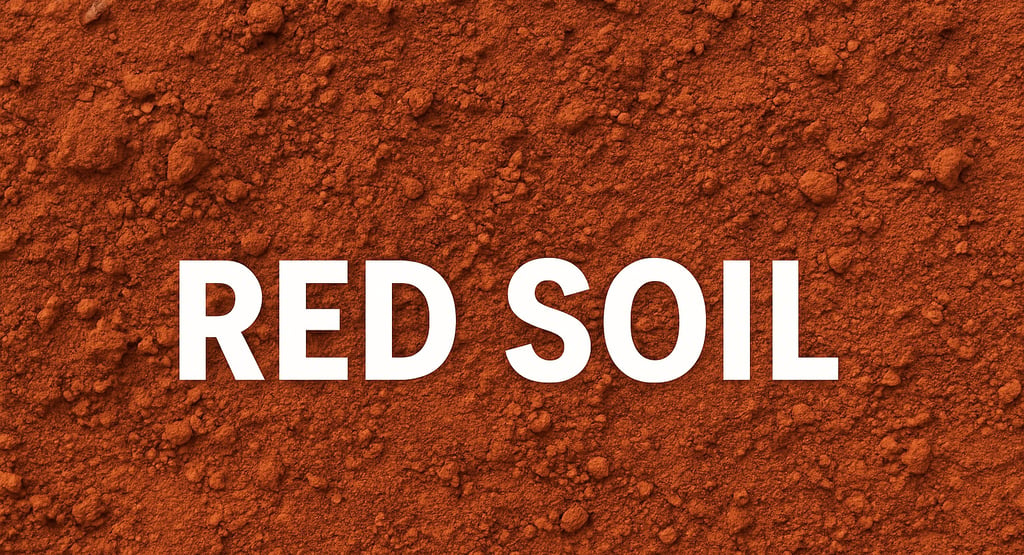The Significance of Red Soil: Advantages and Applications
Red soil is a type of soil predominantly characterized by its reddish color, which is attributed to the high iron content within its composition. This type of soil typically forms in areas with a warm, temperate climate.
SOIL HEALTH & FERTILITY
8/25/20258 min read


Introduction to Red Soil
Red soil is a type of soil predominantly characterized by its reddish color, which is attributed to the high iron content within its composition. This type of soil typically forms in areas with a warm, temperate climate, where its formation results from the weathering of parent rock materials, particularly granite and gneiss. The weathering process leads to the leaching of nutrients, giving rise to a soil profile that is often low in fertility but high in specific minerals.
Geologically, red soil can be found in various regions across the globe, including parts of India, Africa, Australia, and the southern United States. In India, for example, the Deccan Plateau is a prominent area where red soil is found, making it integral to the country's agricultural output. This soil type is also prevalent in several tropical and subtropical regions, which contributes to its widespread importance in agriculture and horticulture. The unique physical and chemical attributes of red soil, such as its good drainage properties and alkaline pH, make it suitable for the cultivation of various crops such as millets, pulses, and vegetables.
Notably, the well-defined characteristics of red soil allow for its varied applications in agro-ecological practices. Its texture varies from sandy to clayey, but it generally exhibits a fine to medium texture that facilitates effective root penetration for plants. Additionally, red soil's ability to retain moisture, albeit somewhat limited, provides a favorable environment for crop growth under certain conditions. As we delve further into the implications of red soil in agricultural practices, it becomes crucial to understand its benefits and limitations to enhance productivity derived from this essential natural resource.
Importance of Red Soil in Agriculture
Red soil is recognized for its distinctive characteristics, which significantly contribute to agricultural practices. Comprising high levels of iron oxide, red soil is typically found in regions with a tropical or subtropical climate. This rich mineral composition not only imparts the soil its reddish hue but also enhances its fertility, making it suitable for cultivating a wide variety of crops.
One of the key advantages of red soil in agriculture is its excellent drainage properties. This soil type tends to drain excess water efficiently, which helps prevent waterlogging, a condition that can harm root systems and negatively impact crop yield. Because of this drainage capability, red soil is particularly advantageous for growing crops that require well-aerated conditions, such as millets, pulses, and some vegetables.
Furthermore, the texture of red soil, which can range from sandy to clayey, allows for effective root penetration and nutrient absorption. This versatility enables farmers to cultivate diverse plant species tailored to the local environment and market demands. The presence of essential nutrients, such as phosphorus and potash, within red soil also contributes to enhanced crop growth and productivity. Farmers often observe improved harvests when employing sustainable agricultural practices in red soil-rich areas.
Another critical aspect of red soil is its ability to improve soil structure over time. Practices such as crop rotation, cover cropping, and organic matter application can enrich the soil further, promoting microbial activity and enhancing overall soil health. As a result, adopting these sustainable practices not only leads to increased agricultural output but also supports long-term soil fertility.
In summary, the unique properties of red soil, including its mineral composition and superior drainage capabilities, play a vital role in agricultural success, making it a preferred choice for the cultivation of various crops in many parts of the world.
Advantages of Red Soil
Red soil, characterized by its distinctive reddish color, offers a variety of advantages that make it essential for agriculture and environmental health. One of the key benefits of red soil is its rich nutrient profile, which is primarily attributed to the presence of iron oxides. This nutrient-rich composition promotes robust plant growth and supports diverse crop varieties. As a result, farmers often prefer cultivating crops such as millet, sorghum, and certain legumes in regions where red soil is prevalent.
Another significant advantage of red soil is its excellent drainage capacity. This attribute is particularly beneficial in regions that experience heavy rainfall, as effective drainage minimizes the risk of waterlogging, which can adversely affect root health and crop yields. The granular structure of red soil allows for efficient water infiltration, ensuring that moisture reaches plant roots while excess water drains away. Consequently, this soil type helps maintain optimal moisture levels for plant growth.
Additionally, red soil exhibits a natural acidity that contributes to its fertility. This acidity can help maintain the availability of essential nutrients, fostering an environment conducive to healthy plant development. The moderate pH levels found in red soil also facilitate the growth of a diverse range of plant species, thus enhancing biodiversity within the ecosystem. This diversity is crucial as it supports various insects, birds, and other wildlife, leading to a balanced and resilient ecosystem.
Furthermore, the unique properties of red soil contribute to improving overall soil health. By supporting organic matter accumulation and fostering beneficial microbial activity, red soil plays a vital role in maintaining the long-term fertility of agricultural lands. Thus, its advantageous characteristics not only support crop productivity but also strengthen the environmental framework, creating sustainable agricultural systems that are capable of thriving in various climatic conditions.
Red Soil and Environmental Sustainability
Red soil, known for its distinct reddish hue, is a vital component of many ecosystems, particularly in regions that experience a warm climate. One of the key environmental benefits of red soil is its rich mineral content, which significantly supports soil health. This type of soil is generally enriched with essential nutrients, such as iron and aluminum oxides, which play a critical role in promoting plant growth. The fertility of red soil makes it suitable for various agricultural practices, thereby enhancing food security.
Moreover, red soil contributes to effective carbon sequestration. Through the process of sustainable farming practices, such as crop rotation and agroforestry, carbon dioxide is captured and stored in the soil, which helps mitigate climate change. This sequestration capability is further enhanced when organic matter is added to red soil. The organic matter not only improves soil structure but also increases its overall resilience against erosion and degradation, making red soil an invaluable ally in combating environmental challenges.
Another notable advantage of red soil is its role in promoting biodiversity. The nutrient-rich environment supports diverse microbial life and contributes to a balanced ecosystem. Healthy red soil encourages the proliferation of various flora and fauna, ultimately maintaining the ecological balance. By fostering diverse biological communities, red soil helps ensure that ecosystem services such as nutrient cycling, pollination, and pest control are sustained.
Promoting the conservation and proper management of red soil is essential for sustainable land use. This can be achieved through practices that minimize soil disturbance and promote vegetation cover. By maintaining the integrity of red soil, we actively contribute to preserving the biological and chemical diversity of our ecosystems, thereby playing a significant role in environmental sustainability.
Applications of Red Soil in Construction and Landscaping
Red soil, characterized by its distinctive color and rich iron content, offers numerous applications beyond its traditional agricultural use. In the field of construction, red soil serves as a vital material for various building processes. Its natural composition provides excellent strength and stability when used in masonry and plastering, making it a favored choice among builders. The soil's granulation allows for easy mixing with other construction materials, such as cement and sand, thus enhancing the overall durability of the structures built with it. Additionally, red soil is often employed as a foundation layer for roads and pathways, ensuring buoyancy and reducing the risk of soil erosion.
In landscaping, red soil is prized not only for its functional properties but also for its aesthetic appeal. The warm, earthy tones of red soil complement a diverse range of plant species, creating vibrant garden landscapes. It provides an ideal base for flower beds and decorative gardens, promoting healthy plant growth due to its high nutrient content. Gardeners and landscapers adeptly utilize red soil to create terraced gardens and raised beds, where its drainage capabilities can be fully harnessed.
Moreover, red soil plays a significant role in erosion control. Its unique composition allows for improved soil cohesion, making it less susceptible to being washed away during heavy rainfall. This characteristic is particularly beneficial for hillside landscaping, where the risk of soil erosion poses a substantial threat. Through the strategic use of red soil, landscapes can be designed to effectively manage water runoff, thus preserving the integrity of slopes and preventing loss of topsoil.
In summary, red soil's applications in construction and landscaping underscore its versatility. Its natural properties contribute to the durability of buildings while enhancing the visual appeal of gardens and landscapes. These characteristics make red soil a critical resource within the field, highlighting its significance beyond agricultural purposes.
Challenges and Management of Red Soil
Red soil, known for its characteristic color due to iron oxide, is prevalent in various regions worldwide. However, several challenges impact its agricultural viability. One prominent issue is erosion, which can lead to significant soil degradation. Erosion often occurs due to improper land management practices, heavy rainfall, or deforestation, resulting in a loss of the topsoil layer that is crucial for plant growth. Maintaining vegetation cover can mitigate this risk, as plant roots help to stabilize the soil and reduce runoff.
Another challenge faced by red soil is nutrient depletion. While red soil can be fertile, it often lacks essential nutrients, particularly nitrogen, phosphorus, and organic matter. Continuous cropping without adequate fertilization can exacerbate nutrient depletion, leading to diminished agricultural productivity. To address this, farmers are encouraged to implement crop rotation and intercropping strategies, which can enhance soil fertility through diverse planting systems. Additionally, organic amendments, such as compost and green manure, can supplement the nutrient profile of red soil, promoting healthier plant growth.
Salinity is yet another concern, particularly in regions prone to drought or where excessive irrigation practices are employed. Elevated salinity levels can hinder water absorption by plants, leading to reduced agricultural yields and crop failure. To manage salinity, it is essential to adopt sustainable irrigation practices, such as drip irrigation, which minimizes water usage while ensuring adequate moisture supply to crops. Implementing proper drainage systems can also help to prevent the accumulation of salinity in the soil, promoting a more balanced and productive agricultural system.
Effective management of red soil involves addressing these critical challenges through sustainable practices and innovative solutions. By adopting proper land management techniques and enhancing nutrient availability, the longevity and productivity of red soil can be preserved, ensuring its vital role in agriculture for years to come.
Conclusion: Embracing the Potential of Red Soil
In summary, red soil plays a pivotal role in the agricultural landscape, offering numerous benefits that contribute to sustainable farming practices. This type of soil, characterized by its rich iron content, provides essential nutrients that support healthy plant growth, making it an invaluable resource for farmers and gardeners alike. The unique properties of red soil, including good drainage capabilities and high fertility, make it particularly suitable for cultivating a variety of crops. The adaptability of red soil to different agricultural practices enhances its significance in supporting food security and sustainability.
Furthermore, the ecological advantages of red soil cannot be overstated. Its natural composition fosters diversity in microbial life, promoting a balanced ecosystem that benefits both crops and the environment. Such ecological health is crucial for maintaining soil quality over time, ensuring that this vital resource continues to be available for future generations. It encourages responsible agricultural practices that align with environmental stewardship and sustainability, making the protection of red soil essential for ecological integrity.
As we move forward, embracing the potential of red soil requires a collective effort from farmers, policymakers, and environmentalists to implement sustainable land management practices. This involves monitoring soil health, promoting organic farming methods, and minimizing the use of harmful chemicals. By fostering awareness and educating communities about the importance of red soil, we can ensure that this valuable natural resource is preserved and optimized for its myriad applications, ultimately contributing to a sustainable future. Acknowledging the significance of red soil allows us to harness its benefits while protecting the environment, thus creating a harmonious relationship between agriculture and nature.




"Boosting Crop Growth With Nature's Power"
Contact Us:
E Mail: support@frosil.com
Customer Care: +91 8329592991
FROSIL © 2025. All rights reserved.


'Frosil' is a fertilizer manufacturer committed to enhancing soil health and crop yields. We provide high-quality, eco-friendly products that support sustainable agriculture and help farmers achieve optimal results.
Registered Office: Gat No.96, Near Krushnai Hospital, Tandali. Tal- Shirur, Dist- Pune.
